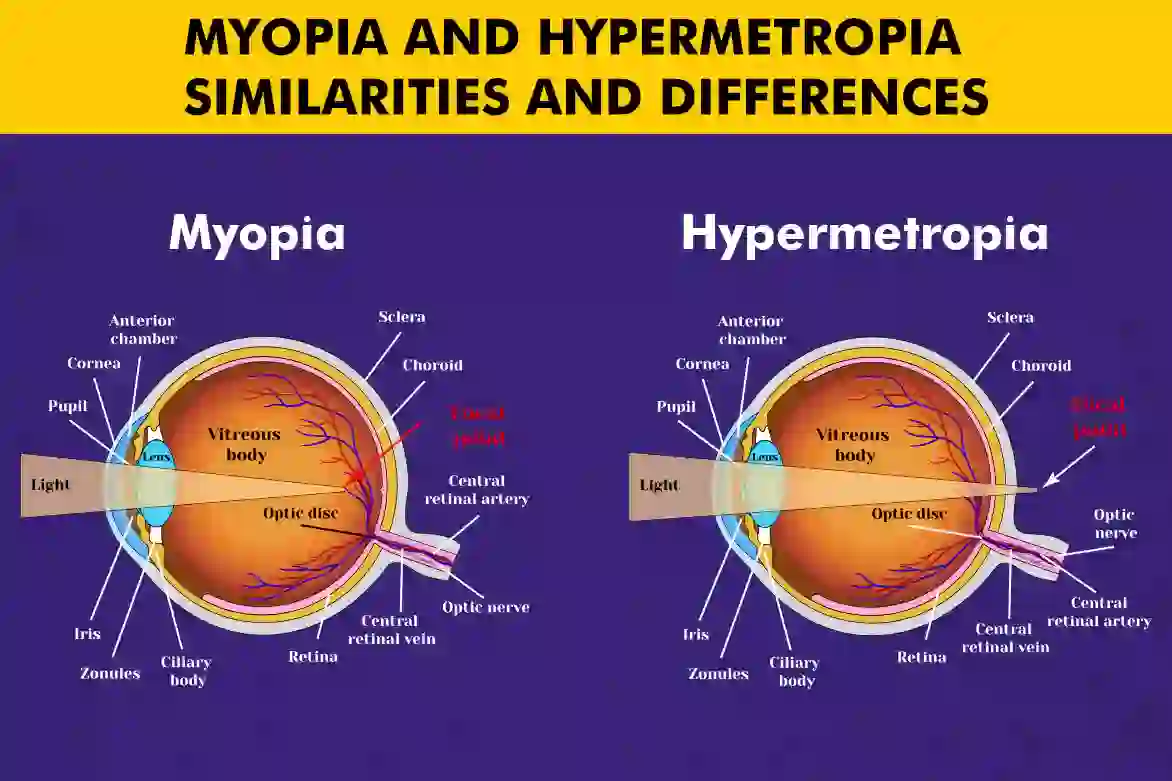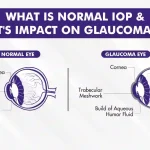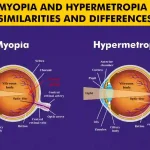Myopia and hypermetropia are two common eye conditions that affect vision. While they both are refractive errors, they have different characteristics and can cause varying degrees of visual impairment. Understanding the similarities and differences between myopia and hypermetropia can help individuals better manage their eye health.
With this blog, we will explore the essential aspects of myopia vs hypermetropia, including their causes, symptoms, diagnosis, and treatment options. We will also discuss the similarities and differences between myopia and hypermetropia and provide tips for prevention and management. So, let’s dive in and learn more about myopia vs hypermetropia!
What Is Myopia (Nearsightedness)?
Myopia, also known as nearsightedness, is a refractive error that affects the ability to see distant objects clearly. People with myopia can see nearby objects clearly, but objects in the distance appear blurry or out of focus. This condition occurs when the eyeball is too long or the cornea is too curved, causing light to focus in front of the retina instead of directly on it.
The exact cause of myopia is not fully understood, but both genetic and environmental factors play a role. Spending excessive time on near work activities, such as reading or using electronic devices, can contribute to the development and progression of myopia.
What Is Hypermetropia (Farsightedness)?
Hypermetropia, also known as farsightedness, is a refractive error that affects the ability to see nearby objects clearly. People with hypermetropia can see distant objects clearly, but objects up close appear blurry or unfocused. This condition occurs when the eyeball is too short or the cornea is too flat, causing light to focus behind the retina instead of directly on it.
Like myopia, the exact cause of hypermetropia is not fully understood. It can be influenced by both genetic and environmental factors. Hypermetropia may be present from birth or develop later in life. Aging can also contribute to the progression of hypermetropia.
Difference Between Myopia and Hypermetropia
While myopia and hypermetropia are both refractive errors that affect vision, they differ in terms of how light is focused by the eye. In myopia, the eyeball is too long or the cornea is too curved, causing light to focus in front of the retina. This results in blurry distance vision. On the other hand, hypermetropia occurs when the eyeball is too short or the cornea is too flat, causing light to focus behind the retina. This leads to blurry near vision.
Another difference between myopia and hypermetropia is the range of vision affected. Myopia primarily affects distance vision, making it difficult to see faraway objects clearly. Hypermetropia, on the other hand, mainly affects near vision, causing difficulties with tasks such as reading or using a computer.
The treatment options for myopia and hypermetropia also differ. Myopia is typically corrected with concave lenses, which help focus light directly on the retina. Hypermetropia, on the other hand, is corrected with convex lenses, which bring the focal point forward and onto the retina.
It is important to note that some individuals may have a combination of myopia and hypermetropia, known as astigmatism. In such cases, a comprehensive eye examination is necessary to determine the appropriate corrective measures.
Myopia and Hypermetropia – Symptoms and Diagnosis
Both myopia and hypermetropia can cause similar symptoms, such as blurred vision, eyestrain, and headaches. However, the specific symptoms may differ depending on whether the condition primarily affects distance or near vision.
Diagnosing myopia and hypermetropia involves a comprehensive eye examination. This may include visual acuity tests to measure the clarity of vision, refraction tests to determine the appropriate corrective lenses, and examination of the eye’s structures to assess overall eye health. Regular eye examinations are important for individuals with these conditions to monitor their vision and ensure timely intervention if needed.
Treatment Options for Myopia and Hypermetropia
The treatment options for myopia and hypermetropia aim to correct the refractive error and improve visual acuity. The most common treatment is the use of corrective lenses, such as glasses or contact lenses. For myopia, concave lenses are used to diverge light rays and bring the focal point back onto the retina. These lenses help in seeing distant objects clearly. Hypermetropia is corrected with convex lenses, which converge light rays and shift the focal point forward onto the retina. These lenses assist in seeing nearby objects clearly.
In addition to corrective lenses, refractive surgery may be an option for eligible individuals. Procedures like SILK, SMILE, Contoura Vision, LASIK (Laser-Assisted in Situ Keratomileusis) and PRK (Photorefractive Keratectomy) can reshape the cornea to correct the refractive error. However, it is essential to consult with an eye care professional to determine the suitability of these procedures.
Regular eye examinations are crucial for monitoring the progression of myopia or hypermetropia and ensuring that the current treatment remains effective. Any changes in vision should be promptly reported to an eye care specialist.
Similarities Between Myopia and Hypermetropia
While myopia and hypermetropia have distinct characteristics, they also share some similarities. Both conditions involve refractive errors, meaning that light does not focus directly on the retina. Instead, it focuses either in front of or behind the retina, causing blurry vision.
Myopia and hypermetropia can be influenced by genetic factors, and they may also be affected by environmental factors such as prolonged near work activities or excessive screen time.
Prevention and Management
While it may not be possible to prevent myopia or hypermetropia entirely, certain measures can help reduce the risk of their progression. These include:
- Taking regular breaks from near work activities and focusing on distant objects to reduce eye strain.
- Practicing good lighting and posture when reading or using electronic devices.
- Maintaining a healthy lifestyle, including a balanced diet and regular exercise, to support overall eye health.
- Ensuring proper eye protection, such as wearing sunglasses with UV protection, to minimize potential damage from excessive sunlight exposure.
Additionally, individuals with myopia or hypermetropia should follow their prescribed treatment plan, which may include wearing corrective lenses or undergoing refractive surgery. Regular eye examinations are essential for monitoring the condition and making any necessary adjustments to the treatment plan.
Conclusion
Myopia and hypermetropia are common eye conditions that affect vision. While myopia causes difficulty seeing distant objects clearly, hypermetropia affects the ability to see nearby objects clearly. Both conditions involve refractive errors and can be influenced by genetic and environmental factors.
Understanding the similarities and differences between myopia and hypermetropia is crucial for individuals to manage their eye health effectively. Regular eye examinations, following the prescribed treatment plan, and adopting preventive measures can help individuals maintain good vision and overall eye health.
If you have any concerns about your vision or eye health, it is recommended to consult with an eye care professional. They can provide personalized advice and guidance based on your specific condition.
FAQs
Is myopia plus or minus?
Myopia is commonly referred to as nearsightedness and is denoted as a negative value in terms of diopters. So, myopia is indicated by a minus (-) sign.
Is hypermetropia lens plus or minus?
Hypermetropia is commonly referred to as farsightedness and is denoted as a positive value in terms of diopters. So, hypermetropia is indicated by a plus (+) sign.
Is hyperopia better than myopia?
Neither hyperopia nor myopia is inherently better than the other. The impact of these conditions on vision varies depending on the individual and the degree of refractive error. Both conditions can be effectively managed with appropriate corrective measures.
Can you be nearsighted in one eye and farsighted in the other?
Yes, it is possible to have different refractive errors in each eye. This condition is known as anisometropia. An individual may be nearsighted (myopic) in one eye and farsighted (hypermetropic) in the other.
What is the difference between myopia and hypermetropia?
The main difference between myopia and hypermetropia lies in how light is focused by the eye. In myopia, light focuses in front of the retina, causing blurry distance vision. In hypermetropia, light focuses behind the retina, resulting in blurry near vision.
What is myopia and hyperopia?
Myopia, also known as nearsightedness, is a refractive error that affects the ability to see distant objects clearly. Hypermetropia, also known as farsightedness, is a refractive error that affects the ability to see nearby objects clearly.







